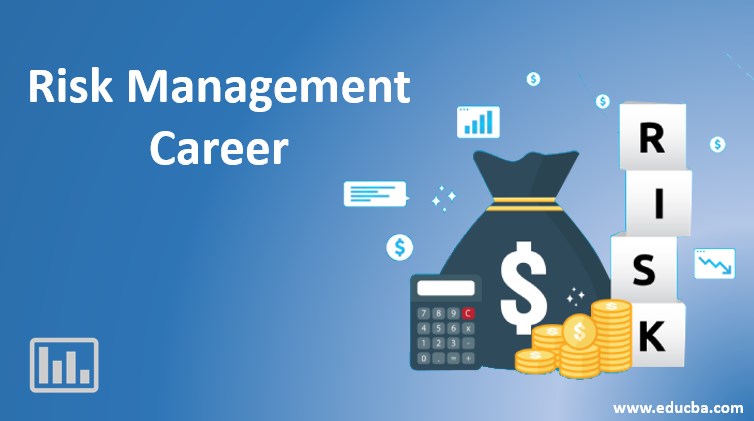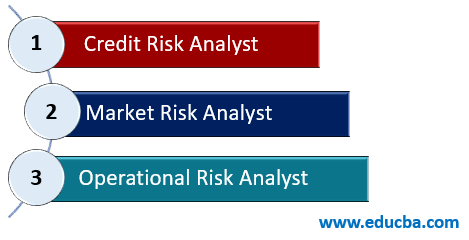Updated July 21, 2023
Overview of Risk Management Career
“Risk management” refers to the process wherein risks are identified and assessed to moderate the effects of uncertainties on investments. Inherently, all businesses have some risk, which can become costly if not taken seriously. As such, risk management personnel play a very important role in the financial world.
Consequently, a career in risk management is considered one of the most highly regarded and highly rewarding job profiles, given the severity of the industry and its importance in profit building. Traditionally, risk management job plays a significant role in ensuring that the grass-root level policy is in sync with the company’s growth objectives.
Top Career in Risk Management
In this article, we will discuss some of the major job profiles in the risk management career path that you can pursue. The job profiles are:
1. Credit Risk Analyst
As a credit risk analyst, you will be responsible for increasing the firm’s profit by using traditional risk management, advanced statistical analytics, machine learning, and other data science techniques.
Responsibilities:
The major responsibilities of a credit risk analyst include:
- Developing and implementing the scoring models used in decision making across the entire customer lifecycle.
- Collaborating with all the IT teams, such as Application, Database Engineers, Business Intelligence, etc.
- Ensuring that all the internal groups implement credit risk policies and offer underwriting criteria for new products and business opportunities.
- Managing credit risk for all prospects and customers by monitoring trends.
- Successfully manage and complete multiple concurrent projects without losing focus.
- Providing justified and timely recommendations as a response to the ad hoc analysis requests raised by the internal groups.
- Acting as an internal resource for SAS best practices.
- Developing actionable reports for the management team.
Educational, Skill, and Experience Requirements:
A credit risk analyst should have the following education, skill level, and professional background:
- A bachelor’s degree in Statistics, Econometrics, Applied Mathematics, or highly quantitative engineering, while a master’s degree in Statistics is preferable.
- One year of relevant work experience.
- Should have a working knowledge of SAS/STAT procedures and Excel.
Salary:
In the US, the median annual salary of a credit risk analyst is around $66,260, with the highest 10 % earning more than $96,000 while the bottom 10% earning less than $47,000.
Source Link: https://www.payscale.com/research/US/Job=Credit_Risk_Analyst/Salary
Top Companies:
In the US, some of the top companies that predominantly hire credit risk analysts include Ernst & Young, PricewaterhouseCoopers, Deloitte and KPMG, pension houses, and investment banks.
2. Market Risk Analyst
As a market risk analyst, you will be responsible for developing, implementing, testing, and maintaining quantitative models to measure the market risk of the trading book products across all the asset classes.
Responsibilities:
The major responsibilities of a market risk analyst include the following:
- Regularly monitor all the latest frameworks for the market risk model, analyze the model, and update parameters as required.
- Developing the existing models in line with the Model Risk Management Policy.
- Interacting with stakeholders of the model life cycle, including the model sponsor, front office data provider, and model validation team.
- Interacting with the regulators in some cases.
- Assisting risk managers and businesses on topics related to the market risk model.
Educational, Skill, and Experience Requirements:
A market risk analyst should have the following education, skill level, and professional background:
- A master’s degree in a quantitative area; or Ph.D. is preferable.
- Strong quantitative skills coupled with the ability to build mathematical models.
- Proficiency in programming languages such as R, Python, and C++.
- Good verbal and written communication skills.
- Previous work experience in trading book products is preferable.
- Recommended qualifications that are preferable include FRM and CFA.
Salary:
In the US, the median annual salary of a market risk analyst is around $72,105, with the highest 10 % earning more than $100,000 while the bottom 10% earning less than $47,000.
Source Link: https://www.payscale.com/research/US/Job=Market_Risk_Analyst/Salary
Top Companies:
In the US, some of the top companies that predominantly hire market risk analysts are the Big 4 companies, insurance houses, and all investment banks.
3. Operational Risk Analyst
As an operational risk analyst, you will maintain and manage the company’s operational risk governance framework.
Responsibilities:
The major responsibilities of an operational risk analyst include the following:
- Reviewing the loss of information captured in the system to assess the root cause and suggest remediation action.
- Tracking the progress of the existing loss events.
- Preparing reports for senior management.
- Assisting in the identification of critical risks and controls of the business.
- Assisting in the Enterprise Risk Management (ERM) reporting using the company’s Operational Risk Management system.
- Managing the ERM reporting cycle and engaging with the stakeholders.
- Supporting the team in performing other key operational risk management activities and preparing reports at a regular frequency, focussing on better depth and value.
Educational, Skill, and Experience Requirements:
An operational risk analyst should have the following education, skill level, and professional background:
- A bachelor’s degree in business management, computer science, finance, or engineering.
- Over 3 years of experience in enterprise / operational risk management, project management, process improvement, assurance, or audit.
- Sound knowledge of investment products, asset management, supporting processes, and operational controls.
- Strong analytical and problem-solving abilities.
- Excellent verbal and written communication skills.
- Ability to express complex concepts in a clear and comprehensible manner.
- Recommended qualifications that are preferable include FRM and PRM.
Salary:
In the US, the median annual salary of an operational risk analyst is around $55,805, with the highest 10 % earning more than $77,000 while the bottom 10% earning less than $41,000.
Source Link: https://www.payscale.com/research/US/Job=Operations_Analyst/Salary
Top Companies:
In the US, some top companies that predominantly hire operational risk analysts include insurance and pension houses, investment banks, and the Big4 audit firms.
Conclusion
So, it can be seen that businesses today are more cautious about their exposure to various internal and external threats. Consequently, these companies are investing heavily in building their ability to identify and avert such loss events by taking pre-emptive measures on a larger scale. As such, a career in the risk management domain is thriving and generating healthy paychecks as companies recognize the importance of having a professionally trained risk manager.
Recommended Articles
We hope that this EDUCBA information on “Risk Management Career” was beneficial to you. You can view EDUCBA’s recommended articles for more information.





